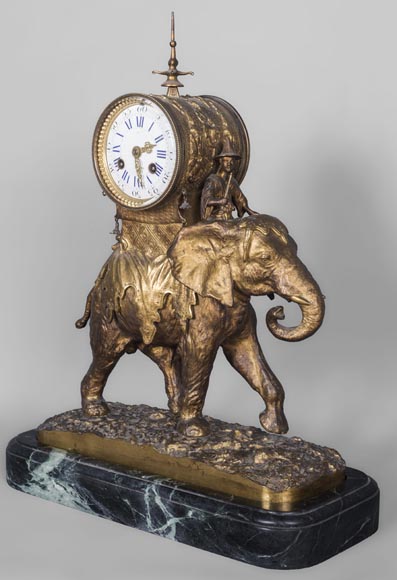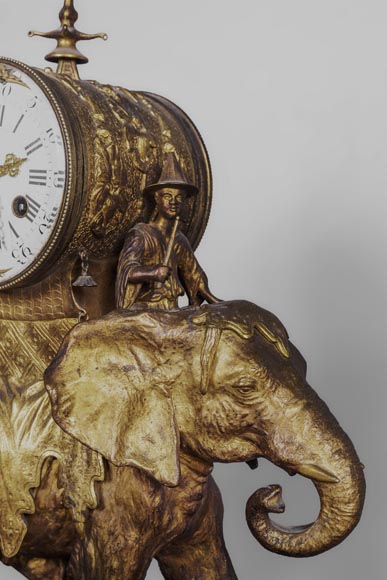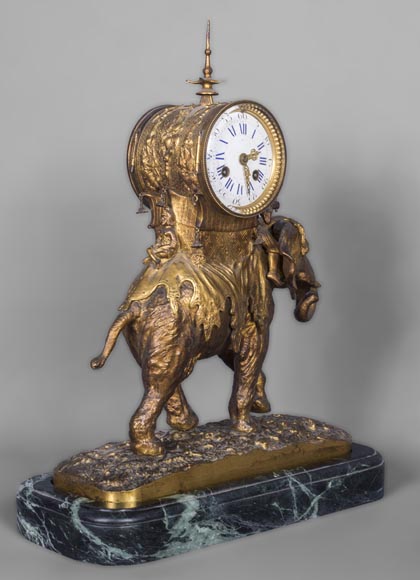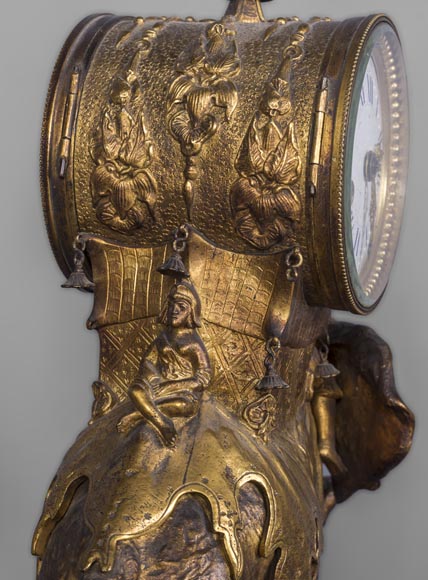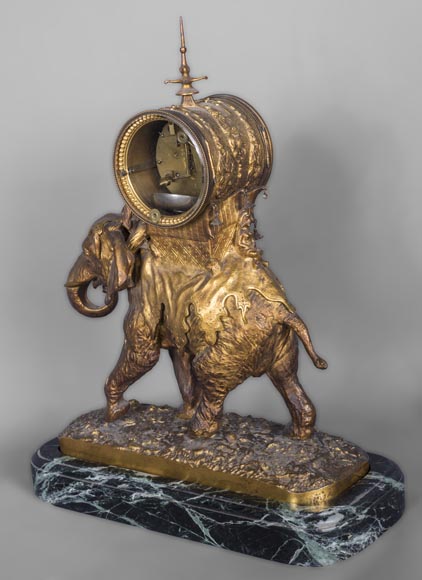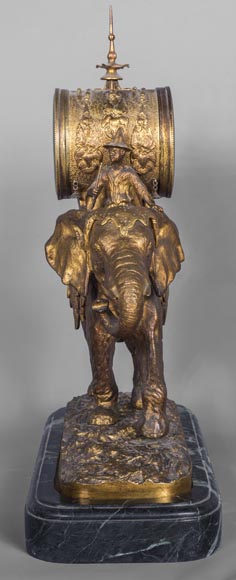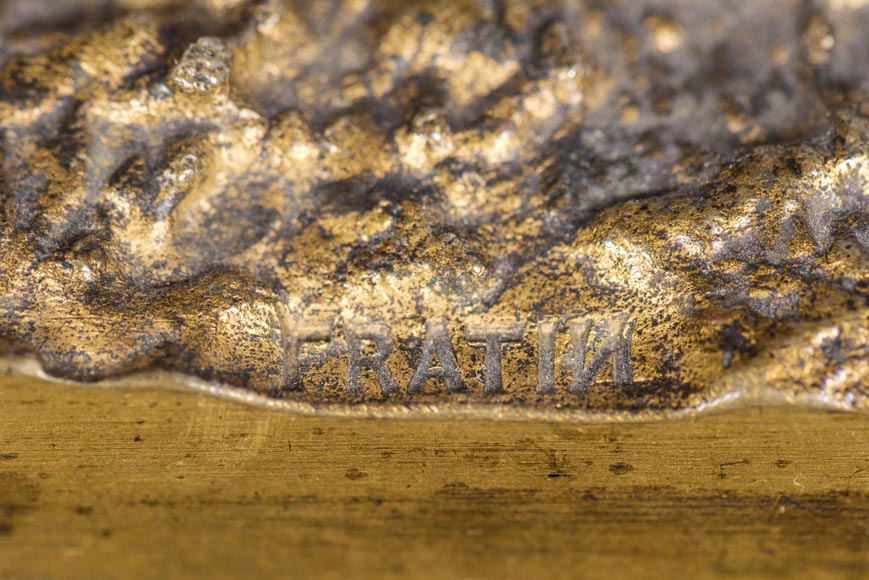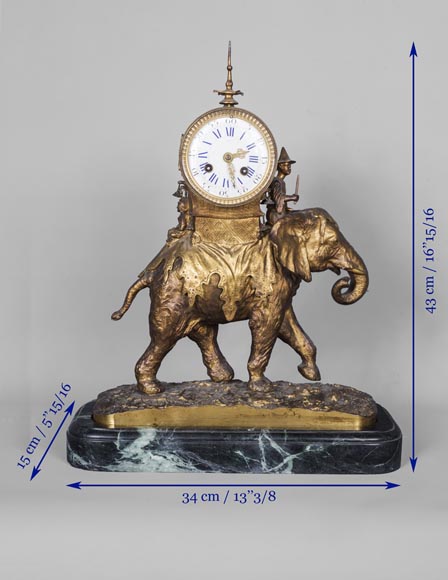Style Other / Ref.11030
Christophe FRATIN (1801-1864) rare Asian elephant clock, in gilded and patinated bronze
Dimensions
Width 13'' ⅜ 34cm
Height 16'' ⅞ 43cm
Depth: 5'' ⅛ 13cm
Origin:
France, 19th century
France, circa 1870
Gilded and patinated bronze, modern marble base.
Signed « Fratin » on the bronze base
This beautiful elephant clock was made in the 19th century by the Animalier sculptor Christophe Fratin. From the reign of Louis XV, clocks representing animals have a great success. With the development of the taste for Orient, exotic animals fascinate and become privileged subjects for sculptors. From the 18th century, the elephant clock is a particularly popular model. Symbol of nobility, wisdom and power, this animal, discovered by the Europeans during the conquests of Alexander the Great, is often represented by Westerners carrying some monumental element on its back.
This image undoubtedly comes from the Eastern tradition of howdahs, Indian name of the pavilions installed on the back of the elephants to shelter travelers. On our clock, the pachyderm supports a heavy drum adorned with exotic flowers enclosing the clockwork. A Chinese character leads the elephant, one hand resting on the animal's head, the other holding a stick. Another character, feminine, is sitting cross-legged at the back of the drum, leaning against it. The dial supported by thick fabrics as well as the rod that surmount it bring verticality to the composition, evoking the monumentality of these animals that the Western imagination has often been pleased to represent. Among the many representations of this type, it is worth mentioning the Napoleonic project of the Elephant of the Bastille, a Parisian fountain that was never realized, but of which a plaster model at scale 1, built in 1814 near the site then destroyed in 1846, was notably quoted by Victor Hugo in a scene of Les Misérables staging the young Gavroche. This monumental fountain, whose creation had been entrusted to the architect Alavoine, was to be surmounted by the colossal statue of an elephant with a tower-shaped howdah.
All the Animalier sculptor talent of Fratin is perceptible in the representation of this elephant whose rendering of the epidermis is precise and realistic. The folds of the trunk and ears, the joints of its imposing legs and the look of the animal are particularly convincing. The fabrics which cover it are the occasion, for the artist, to demonstrate all his dexterity and his mastery; the care given to the treatment of the base is also to be pointed out.
After the revolution of 1848, the slowdown of the art market forced Fratin to turn to auctions to sell his works, mostly with cast rights, an extremely rare process for 19th-century sculptors. In the catalog of one of these sales (April 1850), there is a mention of an "Elephant, palanquin ride", which allows us to date the realization of our model before 1850.
Informations
Price: on request
Recommended for you :
Dimensions:
Width: 35
Height: 42
Depth: 169
Dimensions:
Width: 44
Height: 48
Depth: 18
Dimensions:
Width: 32
Height: 39
Depth: 21
Dimensions:
Width: 18
Height: 33
Depth: 15
Dimensions:
Width: 31
Height: 35
Depth: 19
Dimensions:
Width: 47
Height: 76
Depth: 23
Dimensions:
Width: 30
Height: 38
Depth: 15
Dimensions:
Width: 27
Height: 44
Dimensions:
Width: 38
Height: 69
Depth: 11
Dimensions:
Width: 33
Height: 46
Depth: 17
Dimensions:
Width: 41
Height: 70
Depth: 18
Dimensions:
Width: 68
Height: 95
Depth: 20



